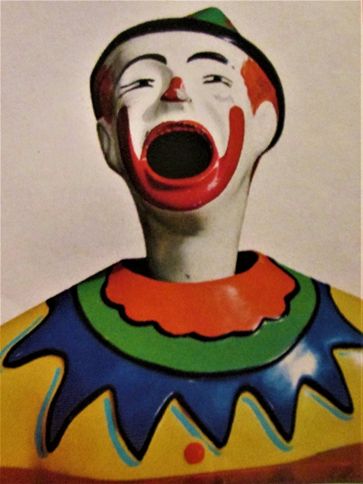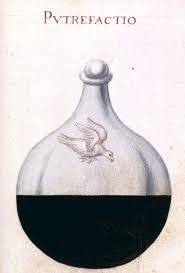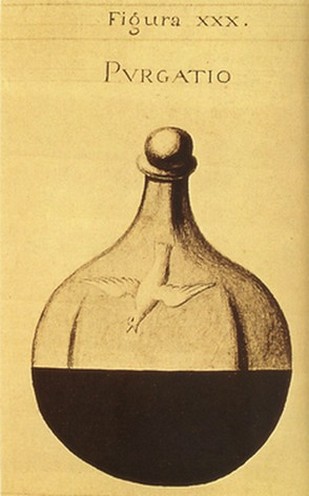

YE MUST MAKE WATER OF YE EARTH & EARTH
OF YE AYRE & AYRE OF YE FIER & FIER OF YE EARTH
Chiara
Crisciani, Hermeticism and Alchemy: The Case of Ludovico Lazzarelli, Early Science and Medicine, Vol. 5, No.
2, Alchemy and Hermeticism (2000), pp. 145-159. [Hermetic texts]
George
O. S. Darby, Ibn Wahshiya in Mediaeval Spanish Literature, Isis, Vol. 33, No. 4 (Dec., 1941), pp. 433-438
Margaret Mendenhall. “The Music of the
Spheres”: Musical Theory and Alchemical Image
http://journals.sfu.ca/pgi/index.php/pacificamyth/article/viewFile/64/89
On the SPLENDOUR SOLIS:
http://blogs.getty.edu/iris/illuminating-alchemys-colorful-peacock-stage/
Theodore
Ziolkowski, Alchemist in Literature, From Dante to the Present
A
clear chronological structure displays the development of the theme across the
period. Considers major works alongside a selection of relevant minor works,
providing a clear pattern by which other works can be measured and related. Relevant
historical and biographical background enables readers to understand where each
work fits into the argument. The index provides an easy reference to the
writers and works discussed
Thomas Willard, Dreams
and Symbols in The Chemical Wedding
https://www.academia.edu/32632993/Dreams_and_Symbols_in_The_Chemical_Wedding
Campbell,
Mary Baine. “Artificial Men: Alchemy, Transubstantiation, and the Homunculus.” Republics of
Letters: A Journal for the Study of Knowledge, Politics, and the
Arts 1, no. 2 (April 30, 2010):
http://rofl.stanford.edu/node/61.
Cesarotti, William A.,
M.A. Tending the fire: The alchemy of
psychotherapy, Pacifica Graduate Institute. 2011: 113 pages
Håkan Håkansson, Alchemy of
the Ancient Goths: Johannes Bureus’ Search for the Lost Wisdom of Scandinavia, Early
Science and Medicine 17 (2012)
500-522
[Håkan Håkansson, Lund University Library]
Khem/texts
Paul T. Keyser, Alchemy
in the Ancient World: From Science to Magic, Illinois Classical Studies, Vol.
15, No. 2 (FALL 1990), pp. 353-378
Mayhew, Nancy, The painter's palette: Alchemy and the act
of painting, M.F.A. California State
University, Long Beach. 2010: 10 pages
Dan Merkur, Spiritual
Alchemy in King Lear, Theosophical
History, A Quarterly Journal of Research, Vol.8, No.10, Oct. 2002,
pp.274-289.
Janne van Berkel, From Alberuni to
Demons of the Flesh. The Historiography of Indian Alchemy. MA-Thesis ,
Utrecht , 2011. [khem texts]
Helmut
Nickel, "The Judgment of Paris" by Lucas Cranach the Elder: Nature,
Allegory, and Alchemy, Metropolitan
Museum Journal, Vol. 16 (1981), pp. 117-129 [art/alchemy] also VENUS
Prophecy,
Alchemy, and the End of Time: John of Rupescissa in the Late Middle Ages by
Leah DeVun - Review by: Chiara Crisciani, The
American Historical Review, Vol. 115, No. 3 (JUNE 2010), pp. 879-880
The Elixir: An
Alchemical Study of the Ergot Mushrooms
Arturo Schwarz,
Indian and Western Alchemy Derivations and Deformations of Patterns, India International Centre Quarterly,
Vol. 8, No. 2 (JUNE 1981), pp. 145-158 [REBIS/Alchemy]
Rosalie Anne Nardelli, Giuseppe Arcimboldo’s Composite Portraits
and the Alchemical Universe of the Early Modern Habsburg Court (1546-1612)
M.A thesis submitted to the Graduate Program in Art History Queen’s University,
Kingston, Ontario, Canada, July, 2014 [alchemy/art]
Persis Berlekamp, Painting
as Persuasion: A Visual Defense of Alchemy in an Islamic Manuscript of the
Mongol Period, Muqarnas, Vol. 20 (2003), pp. 35-59
[The
Silvery Water painting. Alchemical text, c.a. 1399 Topkapi Palce Library, A.
2075, fols. 2b-3a.]
Xxxxxxxxxxx
Traditio
mystica.
The “sacred craft” was
a secret craft. The goddess Isis instructs her son Horus: “Keep it a great
secret [megalomusterion].” The
initiated were forbidden to divulge their knowledge; they could pass it on only
to their “legitimate sons” and to those who were “worthy.” Alchemy, known
through revelation, remained a privilege of the few, and the taboo of
disclosure, well guarded through the ages, in an impressive example of traditio mystica, a very Hermetic
feature.
The
lore of the craft.
Alchemy, hopelessly
aiming at the transformation of metals into gold, has often been viewed as something
like a misguided application of chemistry. Yet its significance lies, indeed
lay even for its practitioners, not so much in the experimental method and the
outcome of metallic transmutation as in other spheres, notably anthropology, religion,
and folklore. The story has been reconstructed by Mircea Eliade: it goes back
to archaic times and surfaced in Hellenistic Egypt. Its protagonist was the
smith, the adept who dominated matter by transforming it. The insights deriving
from his work gave rise to new meanings and symbols: matter was suffering;
transmutation perfected matter; redemption was freedom from matter. In short,
the primary function of alchemy, physical transmutation, escalated into metaphysical
transmutation: the opus alchimicum
became a symbol of the opus divinum. “
Henry Kahane and Renée
Kahane, Alchemy: Hellenistic and Medieval Alchemy, The Encyclopedia of Religion, Second Edition, (1987, p.244-248
http://www.muhlenberg.edu/library/guides/libinst/fys/images/alchemy%20hellenistic.pdf
IMAGE: Alchemical
Athanor - Paul Laffoley * * HERE
Abstract:
This paper shall examine methods of both knowing the self and knowing
the structure of the natural world through images of the garden in several
alchemical manuscripts belonging to Early Modern antiquarian and scientist Elias
Ashmole. In connecting the images of moths, flowers, and greenery in Bod MS Ash
1423 (a recipe book), to those of fruits in Ashmole’s Tradescantian material,
and finally to the images of plants, trees, and their creaturely inhabitants in
the Ripley Scrolls, this essay will explore how the Pre-Lapsarian garden-space
was allegorised in Early Modern images. Like the Johns Tradescant, John Evelyn,
and Hugh Plat, the alchemist in Early Modern England sought the recovery of the
Hesperidean paradise on earth through study and experimentation. Images of the
garden, this essay suggests, functioned to allow both alchemists and other
natural scientists to think through both the macrocosmic order of the world,
and the microcosmic structure of matter. Through seeing the garden as a
laboratory, and the laboratory as a garden, Ashmole’s alchemical images in turn
provoke a broader reading of nature itself as a ‘Book of the World’. The essay
shall connect the garden as a physical space to the garden as an alchemical pictorial
metaphor in order to explore related modes of knowing in Early Modern science.
"Nosce Te Ipsum/ Know Thyself": A Conference on Early Modern Images, History of Art Department, University College London, May 2, 2015
Alexandra Marraccini,
Fleshly wisdoms: image practices, bodies, and the transmission of knowledge in
a sixteenth-century alchemical miscellany, Word
& Image, Vol. 00, No. 00, XXXX 2017 1 [ONLINE HERE]
W. B. Yeats and The Vegetable Phoenix [HERE]
Rania Elhelw, An Analogy between Pictorial Representations of
Numerology in the Ancient Egyptian Civilization and the Islamic Civilization. [HERE]
Catherine Morris Westcott, The
"Parsifal" Influence in the Work of Jean Delville, Journal of the Fantastic in the Arts,
Vol. 3, No. 1 (9), Special Art Edition, (1990), pp. 5-14 [alchemy-art]
Linda Dalrymple Henderson,
Mysticism and Occultism in Modern Art. Art
Journal, Vol. 46, No. 1, Mysticism and Occultism in Modern Art
(Spring,1987), pp. 5-8
Luba Freedman, Neptune in Classical and Renaissance Visual
Art, International Journal of the
Classical Tradition, Vol. 2, No. 2 (Fall, 1995), pp. 219-237 [Arcanum 11]
In his lectures on sculpture, Jacob
Burckhardt characterized the Renaissance as exhibiting the revival of the
images of pagan gods. The question arises, how the images of the pagan gods, as
shaped by Renaissance artists, differ from those made by artists of ancient
Greece and Rome. Although this question can hardly be answered within the scope
of a single paper, I will illustrate it by investigating the image of Neptune.
The choice of Neptune is particularly apt, since Neptune's functions are more
limited than those of several other Olympian deities - that is, his activities
are confined to the maritime domain. Moreover, Neptune serves as an appropriate
subject for discussing the general question posed above because Renaissance
artists had no recourse to ancient representations of this god in monumental
works of art, whereas such models were available to them for other deities,
like Apollo or Venus. Lacking first-hand acquaintance with large-scale
classical works representing Neptune, Renaissance artists thus had to rely on
their own imagination.” 219
Francis T. Marchese, The
Origins and Rise of Medieval Information Visualization
Edward P. Butler, Neoplatonism and Polytheism, From: Essays on a Polytheistic Philosophy of
Religion, pp. 124-139
Julian Strube, The “Baphomet” of Eliphas Lévi: Its Meaning
and Historical Context, Correspondences 4 (2016) 37–79. [Arcanum 15]
David Porreca, Hermes Philosophus: Ramon Martí's Singular
Use of a Mythical Authority. [SUMMARY HERE]
Abraham Abulafia: Meditations on the Divine Name [HERE]
David Frankfurter, The Magic of Writing and the Writing of
Magic: The Power of the Word in Egyptian and Greek Traditions, Helios, vol.21,
no.2, 1994.
The imagery
in the Buch der heiligen Dreifaltigkeit [HERE]
Mark Filipas, A Lexicon Theory of Tarot Origin [HERE]
The
Psychedelic Experience ~ A manual based on the Tibetan Book of the Dead by Timothy
Leary, Ph.D., Ralph Metzner, Ph.D., & Richard Alpert, [HERE]

The saturnine "night of lead" in which the body falls prey to dissolution and putrefaction, is indicated here by the gaping mouth.


Some very
intersting research clues are constantly being posted at:
THE LUXLAPIS RESEARCH GROUP - [HERE]
If you are a Member of Facebook, request to join the Group
Absorbing items on Buddhist Research is posted at my Page on Facebook:
RESEARCH INTO BUDDHIST ICONOGRAPHY - [HERE]
All you have to do is click LIKE.
FOR THE NEWSLETTER:
GO HERE: AND CLICK ON JOIN EMAIL LIST -
Feel free to contact me personally: EMAIL HERE.
A
SMALL ALCHEMICAL OFFERING: